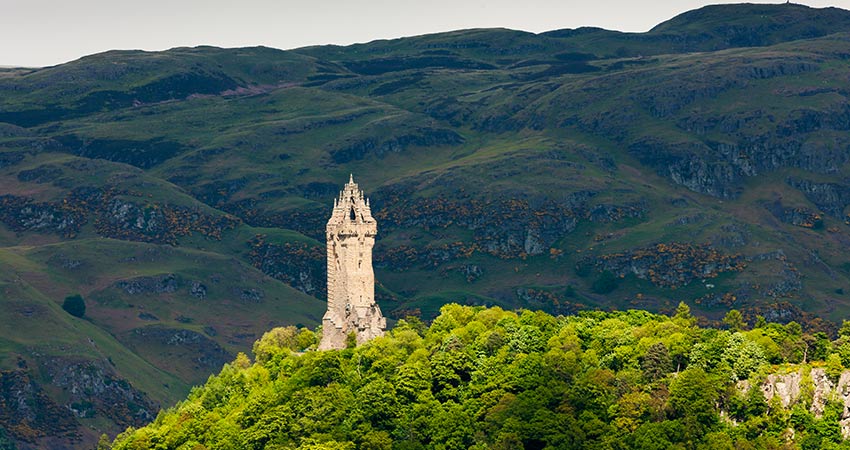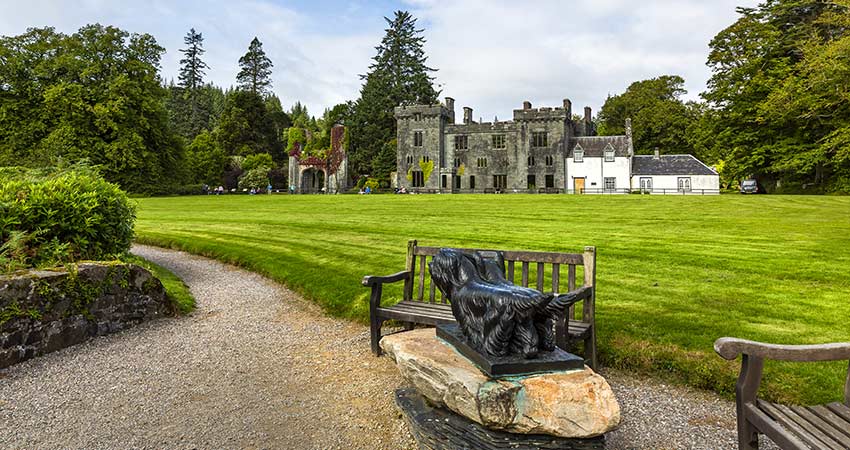Scotland has hundreds of clans, and each has its own place in history. What exactly is a clan? It is an extended family. It includes your parents and siblings, but also cousins, aunts, uncles, grandparents, and even distant cousins. Clans were really a community of people who worked together to support each other’s lives. (This family structure is very similar to that of Native people in the USA today.) The three largest clans in Scotland are Campbell, MacDonald, and MacLeod.
Many clans are attached to castles. Some have been restored and some are a shadow of their magnificent past. Every one tells a story. Here are ten castles to consider visiting on your trip to Scotland:
Inveraray Castle—Clan Campbell

The family has carefully archived events of the past, and you are welcome to visit the clan room. You’ll discover the Campbells’ part in both Scottish and British history, the way lifestyles have changed over time, and which values remain.
Colin Mor Campbell (‘Colin The Great’) was their first Chief; his name, MacCailein Mor, is still used by Chief of the Clan Campbell, The Duke of Argyll, today. Colin Mor Campbell was killed in 1296 and was succeeded by his son Sir Neil Campbell, the friend and brother-in-law of King Robert the Bruce. This castle was built in 1450 by Sir Duncan Campbell, whose grandson became the 1st Earl of Argyll in 1457.
The present Duke, Torquhil Ian, inherited the title in 2001 upon the death of his father. He now combines his duties as Duke, Clan Chief, and Landowner. He also promotes Scotch Whiskies, including Chivas Regal and Glenlivet. He captained Scotland to victory in 2004 and 2005 in the World Elephant Polo Championships. The Duke and his wife, Eleanor Cadbury, have a family of three children and live in Inveraray Castle. Stop by!
Cawdor Castle—Clan Campbell

The medieval tower was built around a legendary holly tree. Cawdor Castle has a mysterious iron gate, moat, drawbridge, turrets, a turnpike staircase, and a vaulted 16th century kitchen. It is steeped in history and atmosphere. Explore the twelve main rooms. They contain collections of rare tapestries, fine art, furniture, ceramics, and sculptures that span 3,000 years.
The castle is a Category A listed building and is most well-known for its gardens, including the 17th century Walled Garden, the 18th century Flower Garden, and the 20th century Wild Garden. The castle grounds also have woods with a huge mix of trees and 100 species of lichen.
Armadale Castle—Clan MacDonald
If you visit the Isle of Skye, explore gorgeous Armadale Castle, former home of the MacDonald’s. Built in 1790, it faces east over the Sound of Sleat. The ruins are romantic, and they are picturesque. Feel free to explore the amazing gardens surrounding the castle; they are protected as a Designed Landscape. Then dip into the museum and library. There you’ll find the legendary story of Clan Donald, one of Scotland’s largest, and most powerful, clans.
Isle of Skye—Clan MacLeod
While on the Isle of Skye, check out the ancestral home of Clan MacLeod—the Isle is packed with major clan sites. Visit the Bloody Stone, Dunvegan Castle with its Fairy Flag, and MacLeod’s Table. The castle is one mile north of Doune town, just off Scotland’s west coast.
Dunvegan is the seat of the MacLeod Chief of the Clan MacLeod. First built as a fortified site in the 13th century, it was developed and grew over centuries. In the 19th century the entire castle was renovated in a medieval style. It has an extraordinary location on a high rock that overlooks an inlet on the eastern shore of Dunvegan.
Castle of Mey—Clan Sinclair
Located in Caithness on Scotland’s north coast, this is just one of the many Sinclair castles in Scotland. When the weather is clear you can see the Orkney Islands from its position. From 1952 to 1996, the Queen Mother, Queen Elizabeth II’s mother, used this castle as her Royal residence. If you’ve watched the Netflix show, The Crown, you will recognize it.
Another notable holding of the Sinclair’s is the 15th century building, Rosslyn Chapel, in Midlothian, Scotland. It is the third Sinclair place of worship in the town of Roslin, the first being inside Roslin Castle. The chapel has been at the center of questions, regarding a connection with the Knights Templar, the Holy Grail, and Freemasonry. It was prominently featured in Dan Brown’s The Da Vinci Code and in the film adaptation of the book. Rosslyn Chapel is privately owned by Peter St. Clair-Erskine, 7th Earl of Rosslyn.
Eilean Donan Castle—Clan Mackenzie
This is one of the most beloved castles in the Scottish Highlands. Named for a 6th century saint, the first fortified structure was built here in the 13th century to protect the area against Viking raids. This original castle became a stronghold of the Clan Mackenzie and their allies, the Clan MacRae. Because the Mackenzie’s were involved in the Jaocibte rebellions, it fell to the MacRae’s.
Sitting on a small island that’s surrounded by lochs and mountains, Eilean Donan is a favorite place for travelers to visit; the entire scene is idyllic and out-of-time. Part of Kintail National Scenic Area, you’ll experience the history of Clan Mackenzie back to the 13th century.
Lennoxlove House—Clan Douglas

Lennoxlove has one of Scotland’s best collections of portraits. It also houses important pieces of period furniture, porcelain, the Boulle cabinet given to the Duchess by King Charles II, and a silver jewelry box that belonged to an important visitor… Mary Queen of Scots.
Isle of Mull—Clan MacLean

On the Sound of Mull, Duart Castle is an ancient MacLean stronghold perched above the sea. The location protected the channel between Mull and the mainland, as well as entrances to lochs. The Castle was built by Chief Lachlan Lubanach MacLean. On its one vulnerable side, the walls are 29 feet high and 10 feet thick. The castle was completely refurbished in 1911 by Sir Fitzroy Donald Maclean, the 26th Chief of the Clan MacLean. The Great Hall, with family portraits and Coats of Arms, is magnificent.
Doune Castle—Clan MacNab
This medieval stronghold is in the Stirling council area of Central Scotland, Perthshire. It is situated in an area of woods and rivers, eight miles from Stirling. It is at the edge of the Trossachs and the Scottish Highlands. Explore the castle grounds, take the woodland walk, and head to the site of a Roman fort. The village of Doune is charming.
Doune Castle has starred in numerous films and TV shows, including Monty Python, The Game of Thrones, Outlander, Outlaw King, Elizabeth: The Golden Age, Ivanhoe, and The Bruce. Visit Doune Castle and you’ll understand why it has attained super star status!
National Wallace Monument—Clan Wallace

Inside the monument, there is the Wallace longsword; it is 5 feet 4 inches long and weighs seven pounds. Walk inside the Hall of Heroes for busts of Robert the Bruce, John Knox, Robbie Burns, Adam Smith, Sir Walter Scott, David Livingstone, and W.E. Gladstone, among others. The Wallace Monument is a place of celebration, contemplation, and an understanding of Scotland’s warrior spirit.
Scotland’s clan and family history is written in her castles, the Highlands and islands, estates, gardens, villages, and cities. Dive into her names, and you’ll discover alliances, enemies, and passions that formed the Scotland of today. If you have family roots in Scotland, look for your clan and castle connections when you visit.
When you dig into your ancestry, you might be surprised to find you still have family in Scotland. Let your Destination Expert help you create a Scotland vacation that includes your own heritage.














